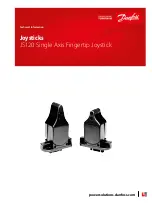
xi
JOG operation
This refers to an operation in which the motor is rotated only while operation commands are being input.
This is used to forcibly rotate the motor using input from an external switch, for instance when to make
adjustments. Depending on the circumstances, this can also be applied to unlimited feeding in some
cases.
JOG positioning operation
This refers to an operation to transfer a JOG operation to a positioning operation by an input from the
external switch.
Home return
The reference position for positioning is called a Home position and an operation to travel to a Home
position is called Home return. The home position should be set in advance. This operation moves to the
home position and its coordinate is set to be 0.
The motor rotation is reversed automatically when the limit input (+) or the limit input (-) is input and the
home position or the near home position is searched to return to the home position automatically.
Pulser operation
A manual operation is available using a device (pulser) which generates pulses manually. The output
similar to an encoder is obtained from the pulser, and the positioning unit RTEX is equipped with
exclusive input terminals. It is also called a manual pulse generator.
Deceleration stop
This is a function that interrupts the operation in progress, slows the rotation and brings it to a stop. The
deceleration time is the deceleration time during the operation.
Emergengy stop
This is a function that interrupts the operation in progress, slows the rotation and brings it to a stop.
Generally, a time shorter than a time for a deceleration stop is set. The deceleration time can be
specified individually.
Positioning table (Table)
A series of positioning data such as acceleration/deceleration time, target speed and interpolation
operation that is necessary for a position control is managed as a positioning table. For example, one
table is necessary for the E point control, and multiple tables are necessary for the P point control and C
point control depending on the number of pass points and continuance points.
Limit input (+), limit input (-)
This is an input to set a limit the motor movement. Limit input (+) is the maximum limit and the limit input
(-) is the minimum limit. They are connected to the AMP for the positioning unit RTEX.
Near home (DOG) input
In order to stop the table at the home position, a position at which deceleration begins is called the near
home position. This is connected to an external input switch or sensor. It is connected to the AMP for the
positioning unit RTEX.
Dwell time
In case of the E point control, a time from the completion of a position commande until the operation
done flag turns on can be specified as a dwell time.In case of the C point control, a time from the
deceleration stop until the next table activates can be specified.
Summary of Contents for AFP243710
Page 16: ...xiv ...
Page 17: ...Chapter 1 Functions of Unit and Restrictions on Combination ...
Page 21: ...Chapter 2 Parts and Functions ...
Page 24: ...2 4 ...
Page 25: ...Chapter 3 Wiring ...
Page 39: ...Chapter 4 Power On Off and Items to Check ...
Page 44: ...4 6 ...
Page 45: ...Chapter 5 Preparation For Operation ...
Page 53: ...5 9 ...
Page 55: ...Chapter 6 I O Allocation ...
Page 63: ...Chapter 7 Setting Tool Configurator PM ...
Page 87: ...7 25 Setting Font Select Option Font in the menu bar The following dialog is shown ...
Page 102: ...7 40 ...
Page 103: ...Chapter 8 Automatic Operation Position Control ...
Page 115: ...8 13 ...
Page 116: ...8 14 When the X axis and Y axis is the moving axes each axis in the above diagram is replaced ...
Page 129: ...8 27 Reference Chapter 10 Manual Operation Home Return ...
Page 139: ...Chapter 9 Manual Operation JOG Operation ...
Page 144: ...9 6 ...
Page 145: ...Chapter 10 Manual Operation Home Return ...
Page 151: ...Chapter 11 Manual Operation Pulser Operation ...
Page 155: ...Chapter 12 Stop Functions ...
Page 158: ...12 4 ...
Page 159: ...Chapter 13 Supplementary Functions ...
Page 171: ...Chapter 14 Precautions During Programming ...
Page 175: ...Chapter 15 Errors and Warnings ...
Page 186: ...15 12 ...
Page 187: ...Chapter 16 Troubleshooting ...
Page 190: ...16 4 ...
Page 191: ...Chapter 17 Specifications ...
Page 241: ...Chapter 18 Dimensions ...
Page 242: ...18 2 18 1 FP2 Positioning Unit Interpolation Type 2 axis type Unit mm 4 axis type Unit mm ...
Page 243: ...Chapter 19 Sample Programs ...
Page 247: ...19 5 ...
Page 250: ...19 8 ...
Page 251: ...Chapter 20 Driver Wiring ...
Page 261: ......














































